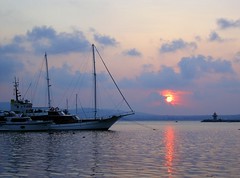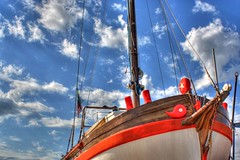
Jolie Brise is a gaff-rigged pilot cutter built and launched by the Albert Paumelle Yard in Le Havre in 1913 to a design by Alexandre Paris. After a short career as a pilot boat, owing to steam replacing sail, she became a fishing boat.
Purchased by E. G. Martin (Commander Evelyn George Martin RNR OBE) in 1923 she was refitted and won the first Fastnet race from seven starters in August 1925. In 1927 Martin sold
Jolie Brise, through an advertisement in Yachting World to Captain Warren Ferrier and his partner Dr Brownlow Smith. An engine and an additional cabin were fitted at Morgan Giles's yard at
Teignmouth. Bobby Somerset, a founder member of the

Ocea
n Racing Club - as was Martin, purchased her in 1928. After competing in the Fastnet, Bermuda and Santander races he sold her four years later to Lt. John Gage RNR. His ownership was only for a year and it seems that in 1934 she was purchased by an American, Mr Stanley Mortimer. Alterations, mostly to the living accommodation were made at a yard in Palma, Majorca and a Gardner diesel was fitted in Marseilles. After cruising the Mediterranean Sea, and with war in the offing Jolie Brise
returned to Southampto
n and was put up for sale. She was
bought by William Stannard but requisitioned by the Royal

Navy who laid her up on a mud berth at Shoreham for the duration of the war. In 1945 she was bought by a consortium headed by Lillian and Jim Worsdell and her name was changed to Pleasant Breeze. A voyage to New Zealand was aborted and when she put in to Lisbon she was acquired by a
Portuguese consortium headed by Luis Lobato. Repaired
and refitted, she was once again listed as Jolie Brise. For nearly 30 years her home
port remained Lisbon but in 1975, partly because of the political situation in Portugal, she returned to the Solent, 50 years after her first Fastnet win.

In 1977 she was bought for Dauntsey's School Sailing Club.
Official Web site

















